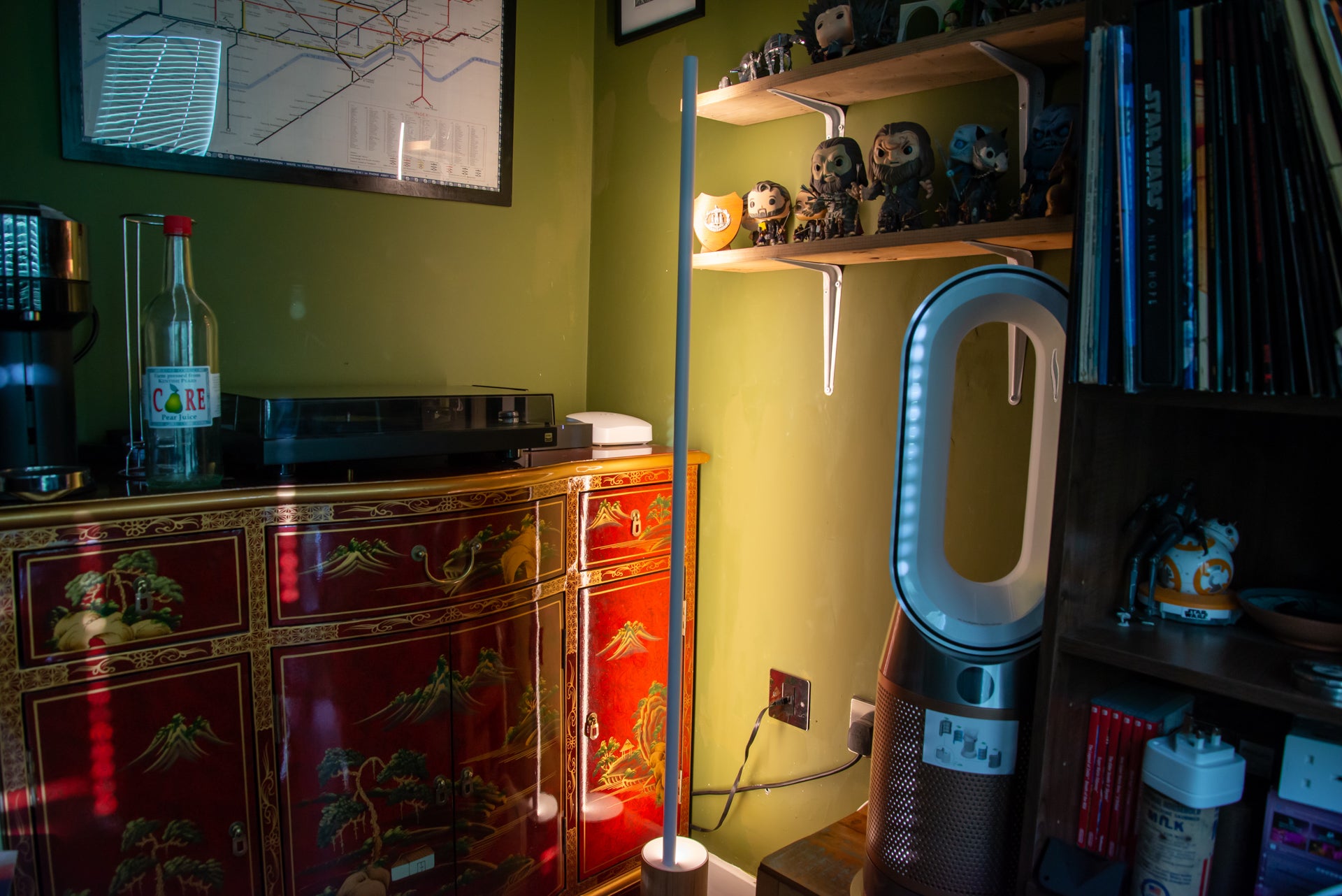Verdict
Whether you want to bring a bit of life to a dull corner or need a way of adding extra light to space, the Philips Hue Gradient Signe Floor Lamp does it all. Excellent colours, expertly blended in its three segments, makes this a fun way to add something extra to a room. It’s fully compatible with the Hue range of controls and app, making it a great add-on for existing Hue owners. It is very expensive, though.
Pros
- Excellent colour reproduction
- App makes it easy to control
- Very bright
Cons
- No onboard controls
- Expensive
-
Smart systemsThe Philips Hue Gradient Signe Floor Lamp works with Amazon Alexa, Google Assistant, Samsung SmartThings, Apple HomeKit and more. -
NetworkingThis lamp is compatible with Zigbee and Bluetooth.
Introduction
Philips Hue’s multi-coloured gradient first came into action as a TV backlight for the Hue Play HDMI Sync Box. Since then, gradient control has been folded into the main Hue app, and we’re seeing a slew of products that use the light strips, including the Philips Hue Gradient Signe Floor Lamp.
Designed to paint a wall in multiple colours, the lamp is bright enough for utility and ambient lighting. It’s backed by the excellent Hue app and a wide range of controls, with the only thing potentially getting in the way being its high price.
Design and features
- Comes pre-assembled
- Easy to set-up
- Works with the full range of Hue controls
The Philips Hue Gradient Signe Floor Lamp is similar to the Govee Lyra Floor Lamp, in that both are floor-standing lamps with gradient light strips in them. While the Govee options needed some assembling, and the finish wasn’t great, the Philips Hue Gradient Signe Floor Lamp comes pre-assembled in its box.
Although that means bigger packaging, there’s no real work getting the Signe set up. Just unbox it and plug it in, and you’re good to go.
This lamp is designed to be placed facing a wall, with the light strip pointing away from you. It’s handy that the power cable input is orientated so that it points away from the wall, making this a neat-looking product even when it’s not turned on.
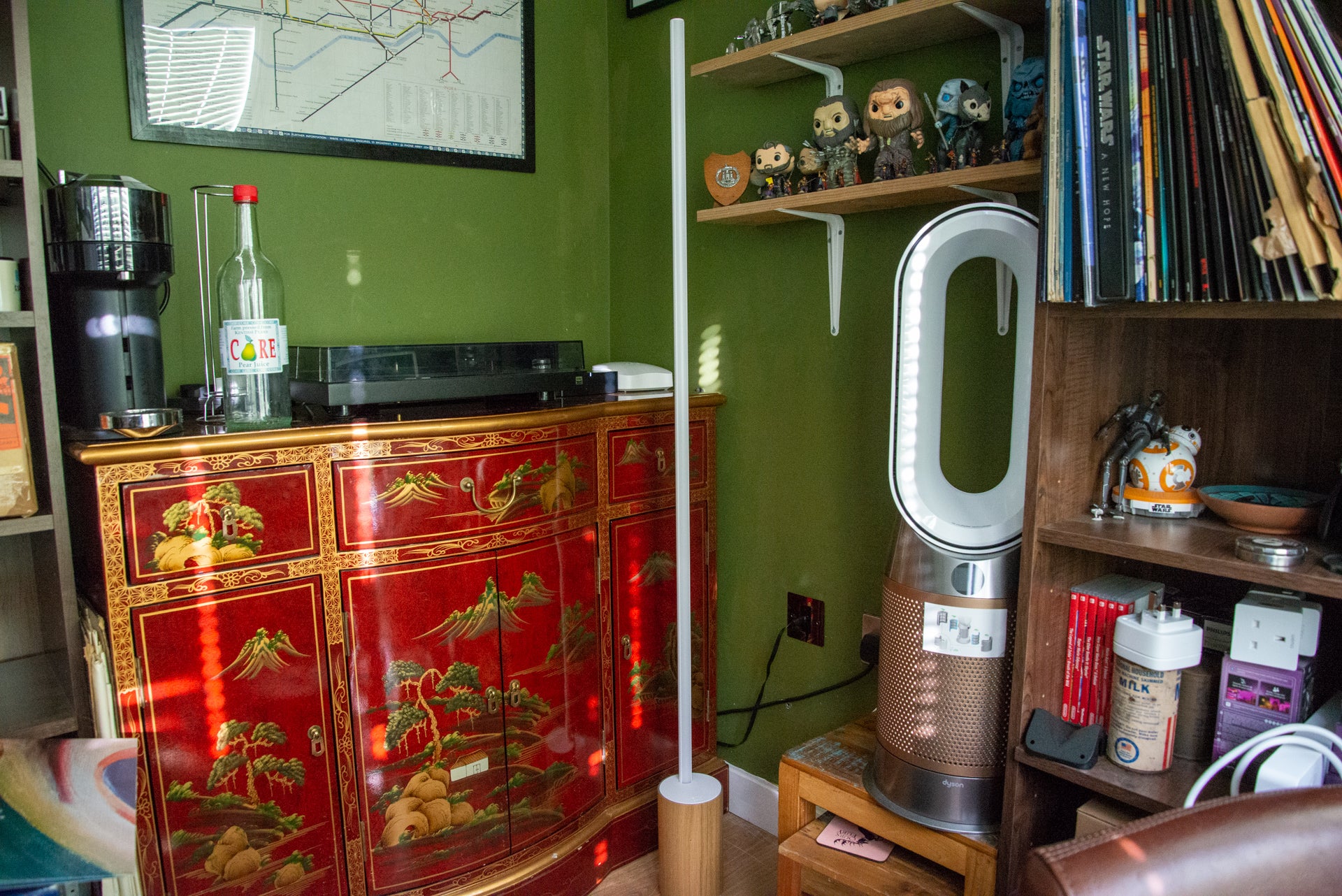
Here, I’m reviewing the Oak version of the product, which has a wood-coloured base. There are also white and black versions of the lamp available for a little less money. Which one to choose really depends on your home: if the lamp base is going to be on show, I’d go for oak; if not, black or white will do. There’s also a table-lamp version of the light.
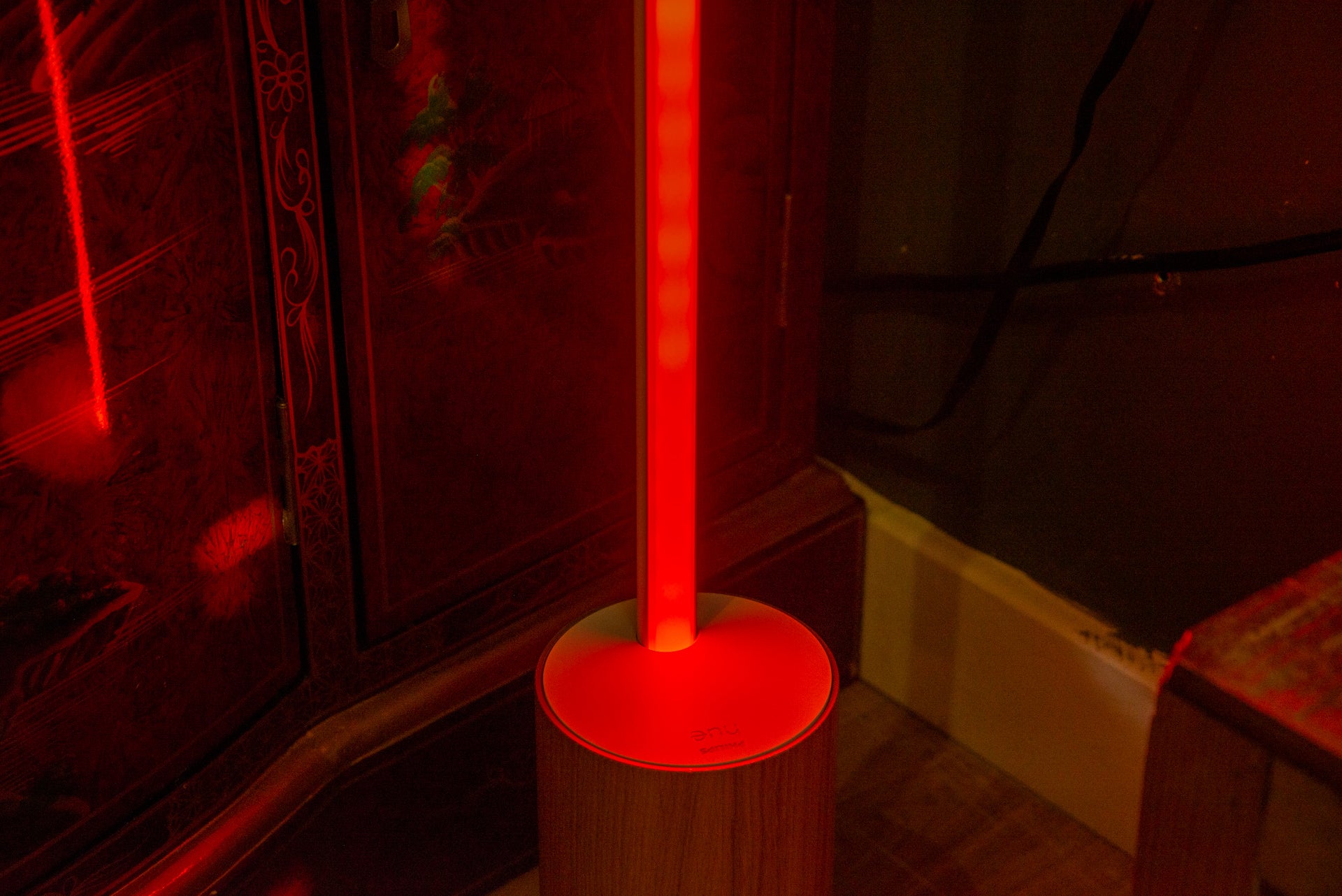
Once plugged in the Philips Hue Gradient Signe Floor Lamp can be connected to your Hue app using Bluetooth or Zigbee. Hue really comes into its own when used with a Bridge and Zigbee, so that’s the version that I went for.
My app wouldn’t discover the light, so I had to enter the Zigbee code. On this lamp, this is printed on the label next to the power plug, not on the lamp itself.
Once in the app, the Philips Hue Gradient Signe Floor Lamp can be added to any room in the Hue app. As I was using the Signe next to a chair in my office, I decided to give it its own room, and then I paired a Hue Smart Button for direct control.
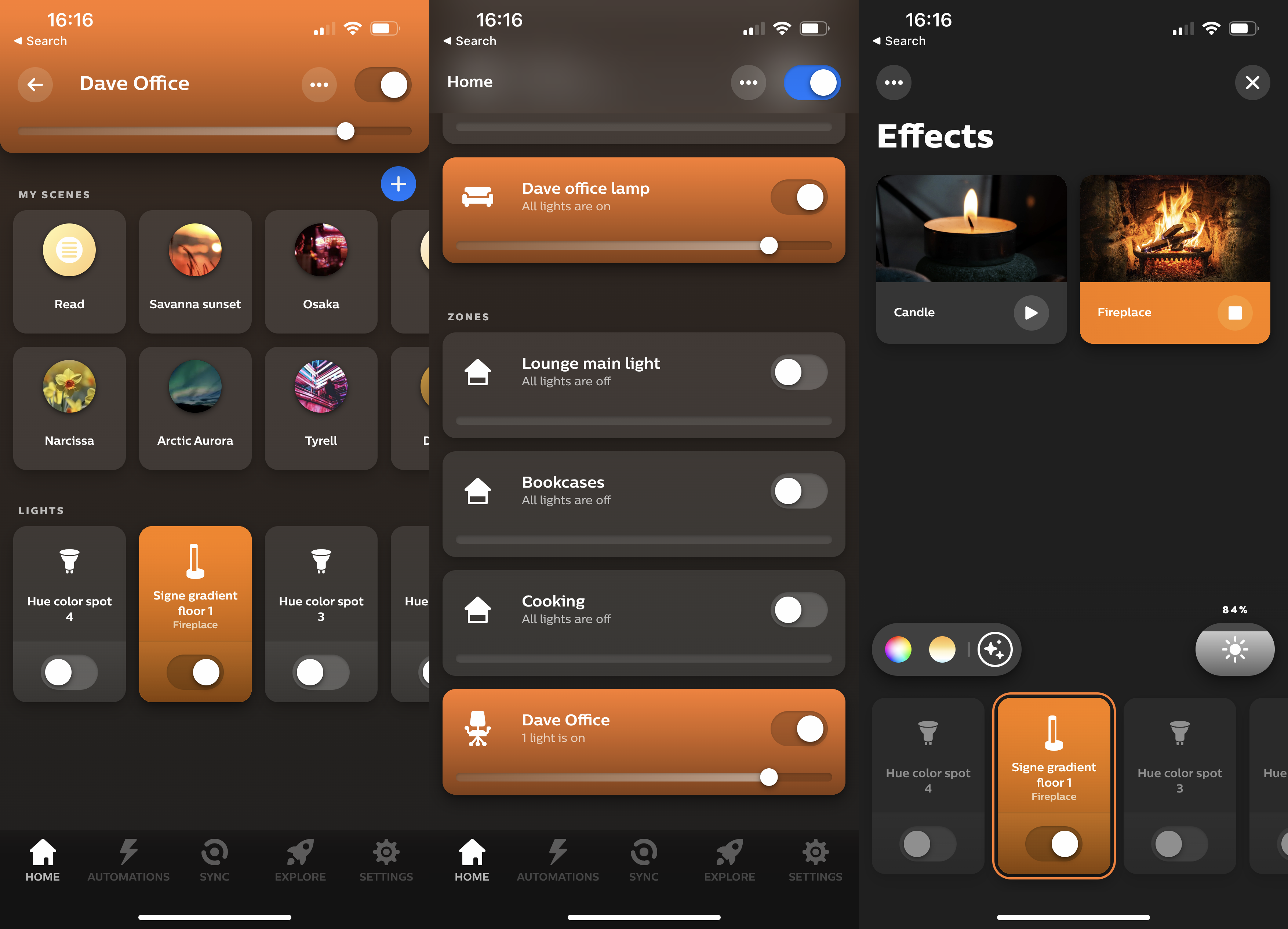
I then created a Scene containing all my regular office lights and the Signe Floor Lamp and used my Hue Tap Dial Switch to control all of the lights and scenes.
As you’d expect, the Signe Floor lamp works with all of the Hue scenes, either in the app or the ones that you create. And it will also work with dynamic scenes, too.
As the Signe Floor Lamp has three individually controllable zones, each scene automatically applies to them. To be fair, the app does a good job of choosing the right colours and blending them together.
If you want to take control, the Hue app also lets you control the lamp’s colour. Press and hold the lamp, and it splits into three linked zones that can be dragged around the colour palette: the first zone is the top of the light, then there are the middle and bottom zones.
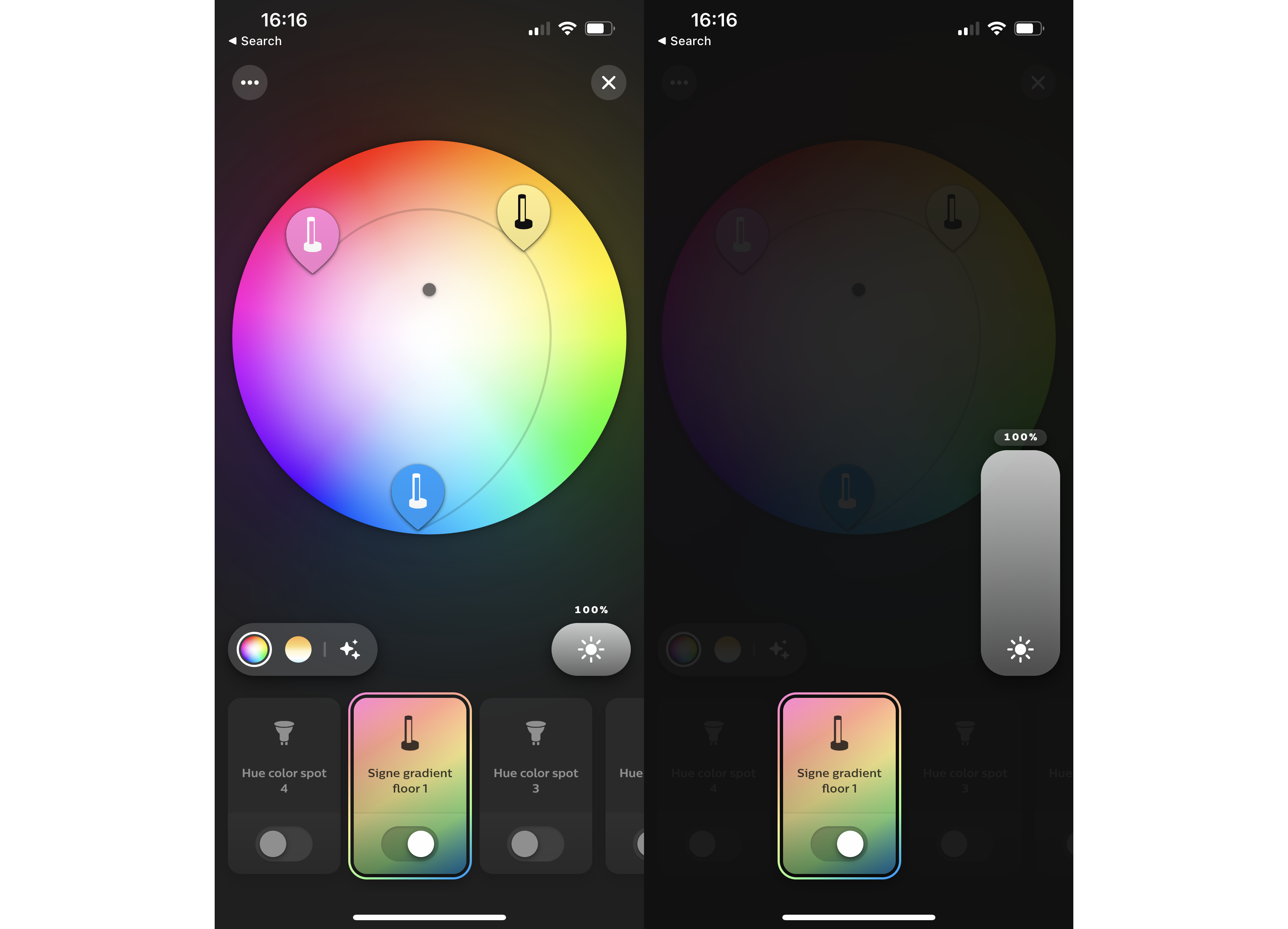
Setting the lamp the colour you want is far easier with this system than the one used by the Govee Lyra.
Govee’s slight advantage is that its lamp ships with a remote control, so you can turn it on and off without the app or a wireless control. I’d like at least an on/off button on this lamp; as it was, I had to set up wireless remotes to operate it.
If you use the Philips Hue Gradient Signe Floor Lamp with a Bridge, it’s HomeKit compliant, although you can only set one solid colour and can’t control the individual segments. It’s a similar story with Amazon Alexa, Google Assistant and Samsung SmartThings control
Performance
- Excellent colour reproduction
- Very bright
Colour reproduction across the range is excellent. Some cheaper lights struggle with some colours, but not the Philips Hue Gradient Signe Floor Lamp. From red to yellow, and green to blue, this lamp is bright across the range.
As the light is designed to be reflected into a wall, the light creates a more contained glow that highlights an area, rather than spilling light out into the room. It’s an effect that works brilliantly in a multitude of rooms. In my living room, the Philips Hue Gradient Signe Floor Lamp helped highlight a rather dull, featureless corner; in my office, sat next to my reading chair, the lamp created a cosy and inviting atmosphere.
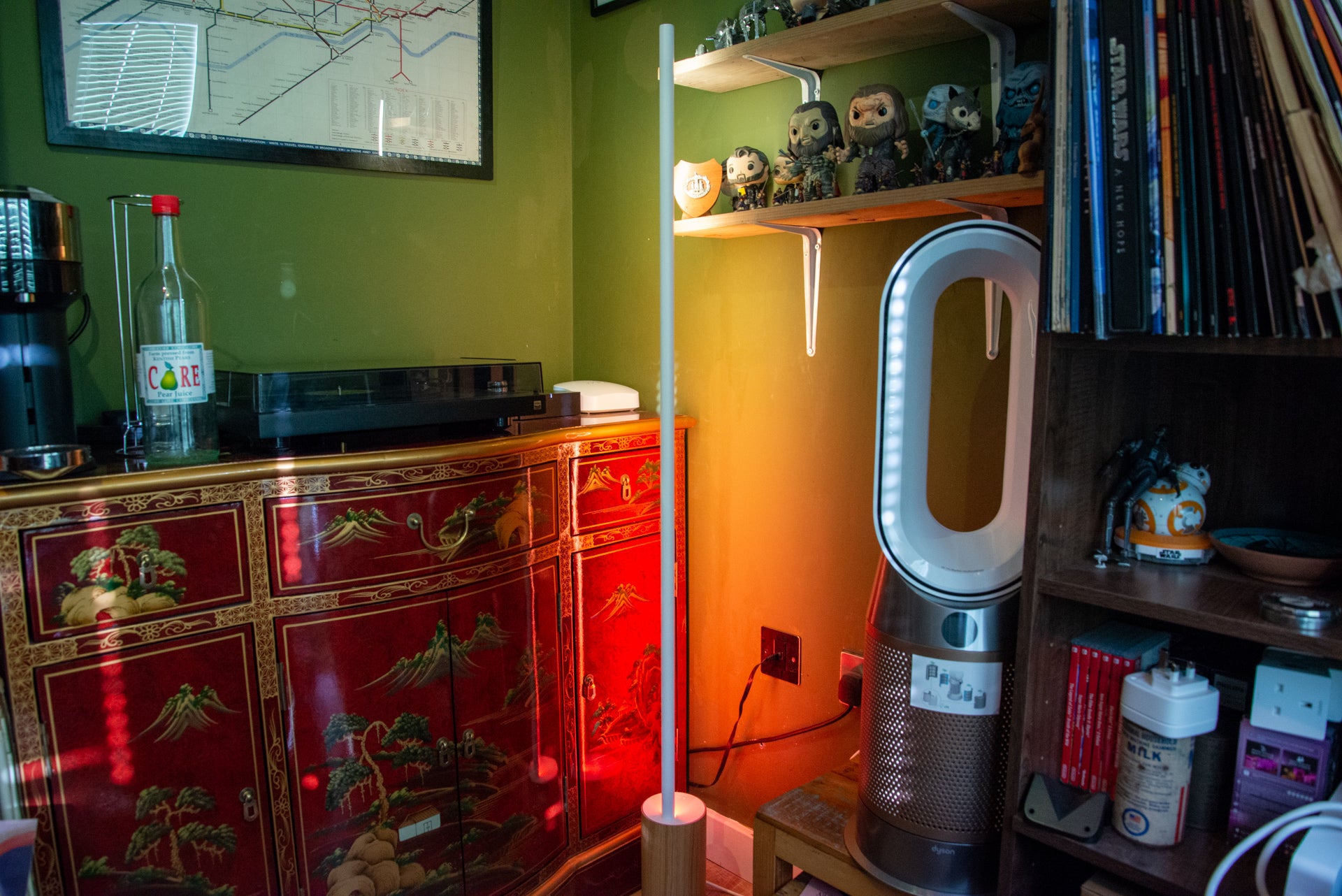
What impressed me was how this lamp is so flexible. It can go from producing gentle colours to give a room a different ambience, to a more utility light. When I used the Concentrate or Reading scenes, the Philips Hue Gradient Signe Floor Lamp was more than bright enough to work by, and that’s with it pointing into a wall, rather than shining out into a room.
Latest deals
Should you buy it?
If you’ve got Hue lights already and want to add something a bit different to a room, this is a flexible lamp that offers utility and ambient lighting.
If you don’t have Hue lights already, then this is an expensive floor lamp, and you can get a similar effect for cheaper elsewhere.
Final Thoughts
It’s properly expensive, but the Philips Hue Gradient Signe Floor Lamp is also properly good. Excellent colour reproduction, stylish design and compatibility with the Hue app and ecosystem make this the best gradient lamp I’ve tested. If you don’t have other Hue devices, then the Govee Lyra Floor Lamp is a cheaper alternative, but the app’s not as good and you have to built the light yourself.
How we test
Unlike other sites, we test every smart home product we review thoroughly over an extended period of time. We use industry standard tests to compare features properly. We’ll always tell you what we find. We never, ever, accept money to review a product.
Find out more about how we test in our ethics policy.
We test how each product integrates with other smart home systems including Amazon Alexa, Google Assistant, Apple HomeKit, IFTTT and Samsung SmartThings
We use each smart home product in a real world setting, integrating it into our home.
FAQs
This model uses the gradient light strip, so it can show three colours at the same time, one per segment.
Yes, you can control the lamp using Bluetooth, but the full range of features and controls is only available if you have a Bridge.
Verdict
Whether you want to bring a bit of life to a dull corner or need a way of adding extra light to space, the Philips Hue Gradient Signe Floor Lamp does it all. Excellent colours, expertly blended in its three segments, makes this a fun way to add something extra to a room. It’s fully compatible with the Hue range of controls and app, making it a great add-on for existing Hue owners. It is very expensive, though.
Pros
- Excellent colour reproduction
- App makes it easy to control
- Very bright
Cons
- No onboard controls
- Expensive
-
Smart systemsThe Philips Hue Gradient Signe Floor Lamp works with Amazon Alexa, Google Assistant, Samsung SmartThings, Apple HomeKit and more. -
NetworkingThis lamp is compatible with Zigbee and Bluetooth.
Introduction
Philips Hue’s multi-coloured gradient first came into action as a TV backlight for the Hue Play HDMI Sync Box. Since then, gradient control has been folded into the main Hue app, and we’re seeing a slew of products that use the light strips, including the Philips Hue Gradient Signe Floor Lamp.
Designed to paint a wall in multiple colours, the lamp is bright enough for utility and ambient lighting. It’s backed by the excellent Hue app and a wide range of controls, with the only thing potentially getting in the way being its high price.
Design and features
- Comes pre-assembled
- Easy to set-up
- Works with the full range of Hue controls
The Philips Hue Gradient Signe Floor Lamp is similar to the Govee Lyra Floor Lamp, in that both are floor-standing lamps with gradient light strips in them. While the Govee options needed some assembling, and the finish wasn’t great, the Philips Hue Gradient Signe Floor Lamp comes pre-assembled in its box.
Although that means bigger packaging, there’s no real work getting the Signe set up. Just unbox it and plug it in, and you’re good to go.
This lamp is designed to be placed facing a wall, with the light strip pointing away from you. It’s handy that the power cable input is orientated so that it points away from the wall, making this a neat-looking product even when it’s not turned on.

Here, I’m reviewing the Oak version of the product, which has a wood-coloured base. There are also white and black versions of the lamp available for a little less money. Which one to choose really depends on your home: if the lamp base is going to be on show, I’d go for oak; if not, black or white will do. There’s also a table-lamp version of the light.

Once plugged in the Philips Hue Gradient Signe Floor Lamp can be connected to your Hue app using Bluetooth or Zigbee. Hue really comes into its own when used with a Bridge and Zigbee, so that’s the version that I went for.
My app wouldn’t discover the light, so I had to enter the Zigbee code. On this lamp, this is printed on the label next to the power plug, not on the lamp itself.
Once in the app, the Philips Hue Gradient Signe Floor Lamp can be added to any room in the Hue app. As I was using the Signe next to a chair in my office, I decided to give it its own room, and then I paired a Hue Smart Button for direct control.

I then created a Scene containing all my regular office lights and the Signe Floor Lamp and used my Hue Tap Dial Switch to control all of the lights and scenes.
As you’d expect, the Signe Floor lamp works with all of the Hue scenes, either in the app or the ones that you create. And it will also work with dynamic scenes, too.
As the Signe Floor Lamp has three individually controllable zones, each scene automatically applies to them. To be fair, the app does a good job of choosing the right colours and blending them together.
If you want to take control, the Hue app also lets you control the lamp’s colour. Press and hold the lamp, and it splits into three linked zones that can be dragged around the colour palette: the first zone is the top of the light, then there are the middle and bottom zones.

Setting the lamp the colour you want is far easier with this system than the one used by the Govee Lyra.
Govee’s slight advantage is that its lamp ships with a remote control, so you can turn it on and off without the app or a wireless control. I’d like at least an on/off button on this lamp; as it was, I had to set up wireless remotes to operate it.
If you use the Philips Hue Gradient Signe Floor Lamp with a Bridge, it’s HomeKit compliant, although you can only set one solid colour and can’t control the individual segments. It’s a similar story with Amazon Alexa, Google Assistant and Samsung SmartThings control
Performance
- Excellent colour reproduction
- Very bright
Colour reproduction across the range is excellent. Some cheaper lights struggle with some colours, but not the Philips Hue Gradient Signe Floor Lamp. From red to yellow, and green to blue, this lamp is bright across the range.
As the light is designed to be reflected into a wall, the light creates a more contained glow that highlights an area, rather than spilling light out into the room. It’s an effect that works brilliantly in a multitude of rooms. In my living room, the Philips Hue Gradient Signe Floor Lamp helped highlight a rather dull, featureless corner; in my office, sat next to my reading chair, the lamp created a cosy and inviting atmosphere.

What impressed me was how this lamp is so flexible. It can go from producing gentle colours to give a room a different ambience, to a more utility light. When I used the Concentrate or Reading scenes, the Philips Hue Gradient Signe Floor Lamp was more than bright enough to work by, and that’s with it pointing into a wall, rather than shining out into a room.
Latest deals
Should you buy it?
If you’ve got Hue lights already and want to add something a bit different to a room, this is a flexible lamp that offers utility and ambient lighting.
If you don’t have Hue lights already, then this is an expensive floor lamp, and you can get a similar effect for cheaper elsewhere.
Final Thoughts
It’s properly expensive, but the Philips Hue Gradient Signe Floor Lamp is also properly good. Excellent colour reproduction, stylish design and compatibility with the Hue app and ecosystem make this the best gradient lamp I’ve tested. If you don’t have other Hue devices, then the Govee Lyra Floor Lamp is a cheaper alternative, but the app’s not as good and you have to built the light yourself.
How we test
Unlike other sites, we test every smart home product we review thoroughly over an extended period of time. We use industry standard tests to compare features properly. We’ll always tell you what we find. We never, ever, accept money to review a product.
Find out more about how we test in our ethics policy.
We test how each product integrates with other smart home systems including Amazon Alexa, Google Assistant, Apple HomeKit, IFTTT and Samsung SmartThings
We use each smart home product in a real world setting, integrating it into our home.
FAQs
This model uses the gradient light strip, so it can show three colours at the same time, one per segment.
Yes, you can control the lamp using Bluetooth, but the full range of features and controls is only available if you have a Bridge.

















